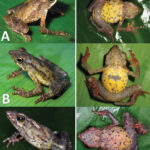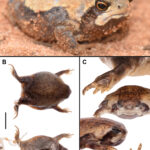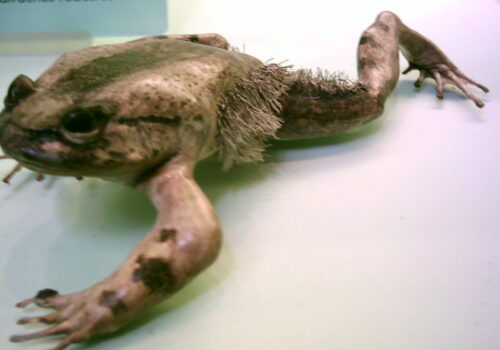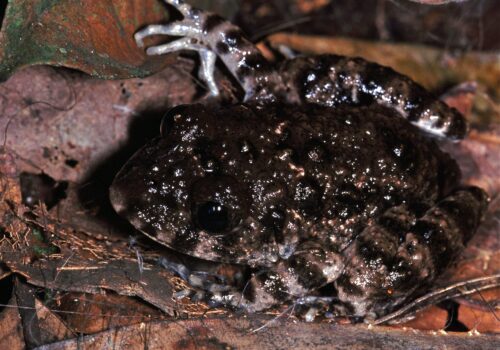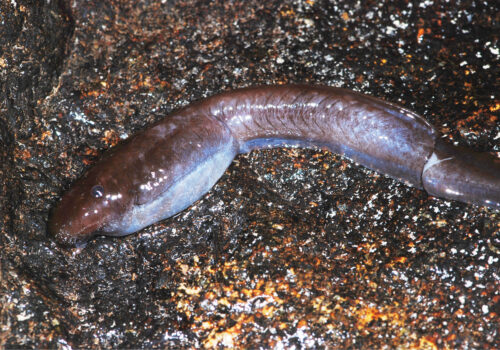Unveiling the Secretive Life of Arthroleptis langeri: Africa’s Hidden Forest Jewel#
In Africa’s mossy forests, hidden amidst leaf litter and the damp shades of dense undergrowth, an elusive miniature thrives—Arthroleptis langeri, commonly known as Langer’s squeaker frog. Small in size yet significant in ecological stature, this amphibian captures the imagination not through spectacular colors but through cryptic beauty, unique behaviors, and its subtle but vital role within its ecosystem.
To encounter Arthroleptis langeri in the wild is a moment of quiet revelation. Infrequently seen yet often heard—thanks to its distinctive vocalizations—this diminutive creature offers invaluable insights into the health of its woodland habitats. Yet, despite its ecological importance, this species remains somewhat of a mystery, overshadowed by larger, more flamboyant species. Today, let’s journey deeper into the quiet forests of Central Africa and unveil the intricate secrets of this remarkable amphibian.
Taxonomy and Classification#
Understanding Amphibian Lineage#
Arthroleptis langeri belongs to the family Arthroleptidae, commonly referred to as squeaker frogs or screeching frogs due to their distinctive vocalization. Within this family, the genus Arthroleptis specifically comprises terrestrial frogs noted for their direct-developing eggs—an evolutionary adaptation that allows embryos to bypass the tadpole stage.
This fascinating adaptation places A. langeri among the few frog species adept at survival without dependence on permanent water bodies, an advantageous trait ensuring survival in areas subject to seasonal rainfall changes. It shares taxonomic ties with other Arthroleptis species, each adapted similarly, yet distinctly evolved to thrive in specific microhabitats.
Natural Habitat#
A Life Within the Leaf Litter#
Arthroleptis langeri is predominantly found throughout humid lowland and submontane forests of Central Africa, particularly in Cameroon, Gabon, Equatorial Guinea, and parts of Congo. The forests within these regions boast lush canopies characterized by towering hardwood trees, thick climbing vines, and intricate networks of forest floor vegetation—ideal habitats for a species specialized in ground-level niche communities.
This frog thrives primarily within leaf litter, an environment that offers a microclimate ideal for its survival, boasting stable humidity, cooler temperatures, and abundant prey. While it can occasionally be seen along forest edges, road clearings, or disturbed patches, it strongly favors undisturbed forests, where leaf litter is deep, humidity is constant, and predators are fewer.
Living primarily terrestrial lives, these frogs rarely ascend branches or moss-covered trunks. Instead, their world is a rich tapestry of fallen leaves, damp earth, concealed burrows, and decomposing logs. The symbiotic relation between fallen leaves, moisture, fungi, insects, and amphibians highlights an example of complex interconnectedness in forest ecology, where every element directly influences survival.
Physical Characteristics#
A Master of Camouflage and Adaptation#
Arthroleptis langeri might initially appear understated compared to flashier tropical amphibians. Adults measure approximately 20 to 30 millimeters—no larger than your thumbnail. However, a closer look reveals the frog’s remarkably intricate beauty.
Their coloration ranges from shades of brown, ochre, grayish to reddish-brown, often intricately patterned with dark spots or bands adorning the back, legs, and sides. Such cryptic coloration is no artistic flourish; rather, it serves as essential camouflage, blending seamlessly with decomposing leaves and forest floors. Their bellies, typically lighter, are less visible beneath, while a subtly pointed snout and prominent eyes allow keen awareness of their surroundings as they blend invisibly into the forest floor.
One distinctive feature is their relatively smooth skin, contrasting many other frogs’ rougher appearance. Legs and toes are suited to ground life—long and slender, equipped for agile leaps, navigating effectively among tangled jungle debris.
Behavior and Life Cycle#
Unique Reproductive Strategies#
Perhaps the most fascinating revelation about Arthroleptis langeri lies in its reproductive behavior. Unlike typical frogs reliant on ponds and puddles for spawning—an adaptation that restricts breeding to wet seasons and permanent water bodies—this species practices direct development. Females lay small clusters of eggs hidden beneath leaf litter, logs, and vegetation, providing moisture and protection.
Here is the magic of evolutionary adaptation: instead of hatching into tadpoles that require aquatic habitats, fully developed miniature froglets hatch directly from eggs. By eliminating the aquatic tadpole stage, these frogs can reproduce in habitats lacking permanent water resources, greatly extending their ability to occupy versatile ecological niches.
The Life of a Forest Predator#
Langer’s squeaker frogs are opportunistic predators. Their diet primarily includes termites, ants, mites, beetles, and tiny spider species abundant in the leaf-litter microhabitat. Hunting mostly at night under cover of darkness, A. langeri sits patiently or slowly stalks prey before swiftly feasting on nutritious small prey through lightning-fast lunges and bites.
Ecological Role#
An Indispensable Piece in a Complex Web#
Every species plays a vital part in maintaining ecological balance, and Arthroleptis langeri is no exception. It serves as both predator and prey, forming vital ecological connections. On one end, this frog diligently controls insect and arthropod populations; on the other, it’s a food source for larger predators such as birds, snakes, small mammals, and larger amphibians within forest ecosystems.
Moreover, A. langeri serves as an ecological indicator species. Sensitive to habitat disturbances, these frogs help biologists gauge forest health including soil integrity, water quality, and biodiversity stability in tropical Africa’s changing climates and landscapes. Declines in their populations often imply an underlying degradation of the habitat…
Threats and Conservation Status#
Habitat Loss Amidst Forest Fragmentation#
Despite their relative adaptability, Arthroleptis langeri populations face serious threats from habitat destruction and fragmentation through deforestation, agriculture expansion, and infrastructure development. Forest clearance directly impacts leaf-litter community complexity required for breeding and hunting. Due to the specificity of their preferred microhabitats, even modest alterations can severely impact populations.
Climate change further complicates conservation concerns, bringing irregular rainfall, drier conditions, or altered insect prey composition, threatening the frog’s intricate life-cycle dependencies. Although currently listed by the IUCN as “Least Concern,” continued habitat loss and changing climate patterns highlight the ever-present need for vigilance and proactive conservation methods.
Cultural and Scientific Significance#
A Window to Ecological Health and Evolution#
Although modest in appearance, frogs such as A. langeri serve as essential barometers of forest ecosystem health. Amphibians worldwide, facing declines due to environmental changes, offer timely warnings indicating potentially severe and ecosystem-wide consequences if conservation measures are neglected.
From a scientific standpoint, direct developmental adaptation provides biological clues for understanding evolutionary steps amphibians take to thrive in diverse environments devoid of permanent aquatic habitats. Investigating these developmental processes helps scientists comprehend evolutionary responses to changing environmental conditions.
Conclusion#
The story of Arthroleptis langeri encapsulates an often overlooked yet incredibly vibrant aspect of biological diversity within Africa’s cherished but threatened forests. Beyond flowing rivers and towering hardwood canopies lies an interconnected tapestry, finely woven by minute creatures nestled within forest floors. As we continue exploring the mysteries hidden amongst fallen leaves, every discovery reaffirms our responsibility to protect these humid, green ecosystems and the delicate lives they shelter.
Encouragingly, awareness can inspire action. By learning about, supporting conservation efforts, and striving to safeguard not only charismatic mega-fauna but also smaller, inconspicuous species like Arthroleptis langeri, we protect the myriad wonders that collectively sustain our planet’s biodiversity.


